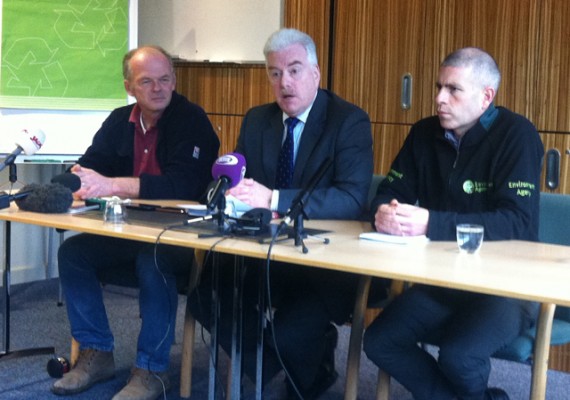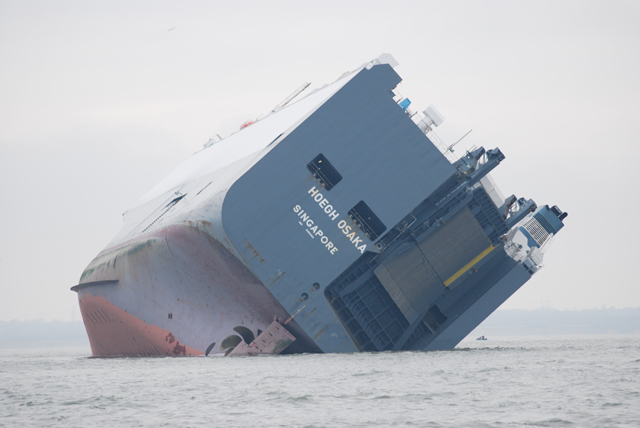Salvors will be using a commercial helicopter rather than sea transport to access the Höegh Osaka cargo ship during rough weather.
An air exclusion zone has been introduced around the stricken Höegh Osaka cargo ship in the Solent.
The new exclusion zone, one mile around and 2,000ft high, was announced on day 10 of the operation, as more rough weather is forecast for the next couple of days.
Höegh Osaka is currently listing at 50 degrees, held in position at anchor by three tugs on the Alpha Anchorage in Portsmouth waters.
Hugh Shaw, the Secretary of State’s Representative for Maritime Salvage and Intervention, told a press conference hosted at the Maritime and Coastguard Agency (MCA) headquarters in Southampton today:
‘We already have a temporary exclusion zone of 300m around the vessel, that’s to give a clear working area for the large tugs, to keep smaller crafts away and stop interference.
‘A decison was made this morning. We’re also putting an air exclusion zone into the area.
‘We’d like to bring in a commercial helicopter, operated by the salvors.’
He added: ‘It will be used to help people on and off the vessel and also for carrying equipment.’
Mr Shaw said: ‘Obviously there is a lot of value on the ship but we’re concentrating our efforts on the salvage operation itself.’
Rough weather preparations
Salvage master Bram Sperling, from the salvage company Svizter, said during the forecast ‘rough weather’, the aim was to keep the vessel in its present location.
In recent strong winds of almost 70 knots the ship moved 100m during a change in the tide. Mr Sperling said: ‘It was under control, we managed to keep her in place.’
He added: ‘We have a contingency plan. We have experienced people on board and we’re confident they will keep the vessel in place but if the wind takes over the vessel or the tugs can’t control it, the ship will end up on a sandbank north to north-east of its current position.
‘It would be in the same situation as when she was aground a few weeks ago.
‘We don’t expect there will be any major issue, and we will do everything we can to avoid this but if there comes a time when the wind takes over the tugs and crew safety are our priority. We want the tugs to take care of themselves at that stage.’
‘A challenging operation’
Mr Sperling said the 15-strong salvage team and the ‘very experienced’ ship’s manager had been working in difficult conditions aboard the listing ship, ‘hampered by bad weather.’
He said some of the cars were underwater after ‘water came in from the little damage caused by shifting cargo’. This has resulted in a film of oil on top of the water in the cargo hold but Mr Sperling said this had been contained and would not leak out overboard.
The vessel now has light after salvors were able to bring fuel aboard for the generator. Extra lashing has been added to ensure the cars ‘stay in place’.
Mr Sperling said the 2,000-3,000 tons of water aboard had been deliberately added to: ‘We’re very lucky the water came in. It has helped to increase stability. We will leave the water in there for the weather coming tomorrow night.
‘We could pump it out but the stability of the vessel would be less. We have the pumps in place. We’re now putting more water in the vessel at a deeper place to make the stability sufficient for if things get rough on Wednesday night with the bad weather.
‘Hopefully with a few days of good weather we can put in place plans for the vessel to come upright.’
Subject to improved weather conditions, salvors hope to get the vessel upright with just 5-10 degrees of list early next week, and moved into Southampton port.
Once upright, the ship’s systems can be used, including the generator and ballast pump.
‘Excellent work’
Michael O’Neill, chairman of the Solent Environment Group, said the Solent and Southampton waters are highly designated from an environmental point of view, however the vessel’s current location was ‘where the risk was the lowest’ according to Natural England experts.
He said: ‘The risk to the environment remains low, mainly thanks to the excellent work of the salvors who have contained the incident and stabilised the vessel.’
Contingency plans are in place ready to respond to any pollution including the deployment of oil booms, described as ‘big orange sausages’, plus plans to contain any lost oil at sea.
In a statement, the MCA said today’s ‘reasonably good’ weather and relatively calm waters had enabled two new pumps to be installed.
The MCA said the helicopter had been scheduled to arrive on scene this afternoon and divers had been expected to inspect the hull.
A tug that was damaged at the weekend after colliding with the ship during bad weather has been repaired and is back in action.
The MCA said: ‘Because all salvage activity is highly dependent on the weather the activity on scene is likely to be curtailed tomorrow as the forecast is for strengthening winds reaching a peak between 1800 Wednesday and 0600 Thursday.
‘The salvors are confident what with the anchor and three tugs connected the strong winds should not present a problem for holding the ship in place and have extensive contingency plans for any unexpected ship movements.’
Höegh Osaka ‘stable’ despite high winds
The stricken cargo ship Höegh Osaka is currently 'stable' in its new location near Spitbank, in the eastern Solent.
Höegh Osaka on the move
The stricken Höegh Osaka cargo ship is being towed to a new location after self-floating at high water in the…
‘No quick fix’ for operation to refloat Höegh Osaka cargo ship
The stricken Höegh Osaka was 'deliberately grounded' in the Solent, a press conference was told.
Car carrier Hoegh Osaka aground on Bramble Bank
Photos from Sunday 4th January of the car carrier Hoegh Osaka which ran aground on the tail of the Bramble…
Crew rescued from sticken cargo ship
The car carrier remains grounded on the Bramble Bank, listing at 45 degrees, but out of the shipping channel










